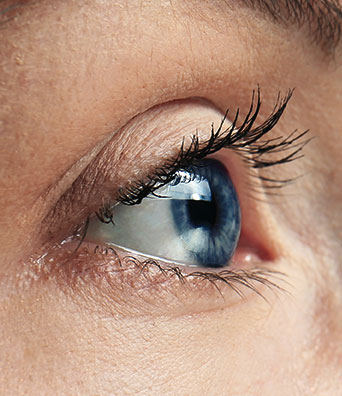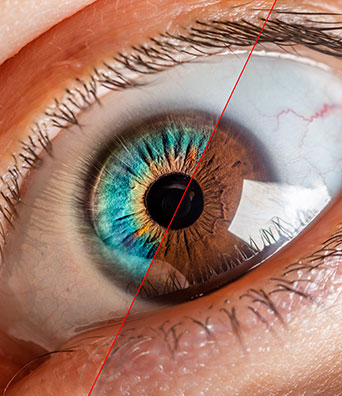Cataract Surgery in Dubai
Cataract is the complete or partial loss of normal eye lens transparency and hence causes darkening. Most cataract cases occur as a natural consequence of aging, but there are other factors such as diabetes, infections, eye injuries, and genetic factors. And there is a congenital cataract that appears on newborns.
Patients with cataracts will experience a gradual loss of vision, and this will affect their daily activities. In advanced cases, this may lead to temporary loss of vision and an increase in intraocular pressure (pressure inside the eye).
Approx. procedure time
10 Mins
Both eyes
Approx. recovery time
1-3 Days
Types of Cataract
Nuclear Cataract: Cloudiness is present in the center of the lens. Here the lens starts to turn yellow and even may turn brown with the progression of Cataract. This can also lead to difficulties to distinguish between colors.
Cortical Cataract: Cloudiness is seen in the outer peripheral or cortical region of the lens.
Subcapsular Cataract: Occurs at the back of the lens capsule or subcapsular region. This develops faster than the nuclear and cortical cataract. The cataract often interferes with the reading vision, reduces the vision in bright light room, and creates glares or halos around light at night time.
- A cataract is the clouding or opacity of the lens inside the eye. The lens has an oval shape like a lentil and lies behind the colored part of the eye, the iris.
- In a normal eye, this lens is clear. It helps focus light rays on to the back of the eye, the retina, which sends messages to the brain allowing us to see. When a cataract develops, the lens becomes cloudy and prevents the light rays from passing to the retina.
- Cataracts usually form slowly, and people experience a gradual blurring of vision.
Advantages Of The Cataract Treatments
Improved vision
Eliminates Color Blindness
Low-risk Process
Quick & Efficient
Improved Quality of Life
Healthy Eyes
About Cataract Surgery
Cataract surgery involves removing the cloudiness in your eyes. The process may only remove the cataract or replace the natural lens with an artificial one depending on the condition of each patient. The benefits of this painless process will help clear your vision. Cataract surgeries are popular with their low complications and high effectiveness in vision distortions. It usually takes around 10 minutes to complete the entire procedure.
Who Needs A Cataract Surgery?
Progression of cataracts can cause vision impairments, color blindness and make it difficult to engage in your daily activities with comfort. Eye doctors usually recommend cataract surgeries once it starts to disrupt your vision and cause problems in reading, driving, and other related regular activities. During the surgery, the replacement through a clear artificial lens will bring back the normal vision taking away all the problems caused by cataract.
Best Cataract Treatments In Dubai
With hands-on experience for many years on cataract surgeries, our eye surgeons will guarantee that you are in safe hands to undergo your cataract treatment for better and clearer vision.
Cataract Surgery
Once the blurred vision interferes with the patient activity, the only solution is surgery. Nowadays, the Cataract surgery is simple and safe and performed under local anesthesia, it takes less than 10 minutes and the visual recovery is very fast in most of the cases. The natural opaque lens is removed and it should be changed for an artificial lens to give the eye the ability to see again. The surgery can be performed on an outpatient basis where you will be discharged home few hours after the surgery.
An ultrasound test will take place before a week to the surgery to measure the size and shape of your eyes to determine the right type of intraocular lens. On your surgery day, before starting the process, eye drops will be given to dilate the pupil. Local anesthesia will also give to numb the area, including sedation to relax yourself. The lens will then be removed and replaced with an artificial lens. There are instances where only the cataract may be removed without implanting an artificial lens.
Two types of methods are involved in cataract surgeries;
Phacoemulsification – Here and an ultrasound probe will be used to break the cataract and suction out the fragments. The back of your eye lens will be left to implant the artificial lens.
Extracapsular extraction – A large incision is made here to remove the lens in one piece. Here, the front capsule of the lens and the cloudy lens comprising the cataract will be removed before placing the artificial lens.
After Process
Following the surgery, your vision will start to improve in a few days. The vision may be blurry at first, and you may find it difficult to see in bright light conditions. You will be given an eye patch to wear on your first day and during your sleep to avoid involuntary touching and rubbing at sleep. Colors may seem brighter after the treatment as cataracts hinder the look of colors. Continuous monitoring will take place with intervals of two days, week, and month after surgery to check on the healing.
Eye drops and oral pills may be prescribed to prevent infections, reduce inflammation, and control eye pressure. Complete healing typically takes around 8 weeks time with successful vision restoration. There are various risk factors that can increase the formation of cataracts. Excessive exposure to sunlight, smoking, obesity, high blood pressure, excessive intake of alcohol, and previous eye surgeries are a few of them.
Which intraocular lens to choose? Monofocal or multifocal?
There are two kinds of implants: monofocal or multifocal. Monofocal lenses are designed for excellent far vision and we will need glasses for near vision.
Monofocal lenses are also advised in cases with other ocular problems (glaucoma, retina) Multifocal intraocular lenses currently are designed to have three main focus: far (driving), intermediate (computer) and near (reading). The objective is to reduce your dependence on glasses after the surgery. This kind of implant is recommended in eyes with no other ocular pathology.
The Eye surgeon in Dubai will advise the right implant for each case, depending on eye examination, patient requests and activity considerations.
Cataract Curiosities
Sir Harold Ridley was the first to successfully implant an intraocular lens on 29 November 1949, at St Thomas’ Hospital in London. It is said the idea of implanting an intraocular lens came to him after an intern asked him why he was not replacing the lens he had removed during cataract surgery.
The intraocular lens did not find widespread acceptance in cataract surgery until the 1970s when further developments in lens design and surgical techniques had come about. The estimated number of surgeries worldwide by 2010 (for cataract surgery) by the World Health Organization was 20 million per year and has projected increased IOL surgeries to reach 32 million worldwide by 2020.
Cataract Surgery FAQs
Book An Appointment
Fill the form below or call/whatsApp +971 50 309 3131 to book an appointment.
Early treatment can prevent long-lasting consequences

